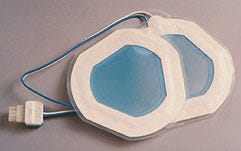Double-Coated Adhesive Tape Eliminates a Sticky Operation
March 1, 1998
Double-Coated Adhesive Tape Eliminates a Sticky Operation
Polyethylene foam tape allows a cleaner, more efficient process as compared to hot-melt

A manufacturer of disposable stimulation electrodes used for defibrillation, ECG monitoring, and external pacing wished to update the design of its R2 pads to enhance quality and performance and, at the same time, simplify the manufacturing process.
Design engineers at Cardiotronics Systems Inc. (Carlsbad, CA) determined they could improve the pad assembly process by substituting a double-coated foam adhesive tape for the messy hot-melt adhesive and single-sided vinyl adhesive tape combination the company had previously been using.
Cardiotronics sought a double-coated foam adhesive tape that would provide the performance required. It also had to be biocompatible and capable of adhering reliably to human skin. With these imperatives in mind, Cardiotronics approached the Medical Products Group of Scapa Tapes (Windsor, CT), knowing that the firm specializes in customizing products for specific applications.
Scapa custom designed a cross-linked, double-coated polyethylene foam tape for the Cardiotronics R2 pad. Not only is the double-coated tape easier to apply, cleaner, and more environmentally friendly than the hot-melt process, but it also provides uniform bonding and stress distribution on the pad. The tape features a hypoallergenic acrylic adhesive formulated for reduced skin sensitivity on direct contact. Because the tape has adhesive on both sides of the foam substrate, it eliminates the time-consuming and messy hot-melt adhesive step, thereby simplifying the production process and increasing product quality.
The outer border of the newly designed pad comprises a 1-in.-wide ring of double-sided foam tape. One side is joined to a similar ring of single-coated foam tape, which is bonded to electrically conductive tin. The other side of the double-coated foam tape retains its liner until it is ultimately used on a patient's skin.
By incorporating Scapa's double-coated polyethylene foam tape into the manufacturing process, Cardiotronics reduced the assembly time required for each pad. Production of the R2 pad still requires some hand assembly; however, instead of applying a messy and time-consuming hot-melt adhesive to bond the two substrates, a production worker simply removes the liner from one side of the double-coated tape and quickly and easily adheres the tape directly onto the single-coated vinyl tape. The foam tape also provides a stronger, more enduring bond than is possible with a hot-melt process.
According to Tim Way, general manager of Cardiotronics, "Scapa's Medical Products Group worked with us to develop a superior product which met our needs. By replacing hot-melt adhesives with the high-performance medical foam tape, we simplified the bonding process and virtually guaranteed that a consistent amount of adhesive is applied every time a pad is manufactured. Our R2 pads are now even higher-quality products, and they're produced faster than ever before."
Scapa Tapes' Medical Products Group's ability to customize a specialized adhesive tape product resulted in a more efficient manufacturing process and a sturdier construction of Cardiotronics's R2 pad.
For more information on tapes and adhesives from Scapa Tapes' Medical Products Group, call 860/688-8000.
You May Also Like


